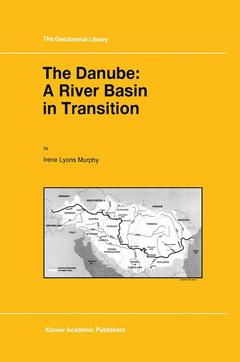Description
The Danube: A River Basin in Transition, Softcover reprint of the original 1st ed. 1997
GeoJournal Library Series, Vol. 40
Author: Murphy I.L.
Language: English
Subjects for The Danube: A River Basin in Transition:
Keywords
Publication date: 10-2012
274 p. · 16x24 cm · Paperback
274 p. · 16x24 cm · Paperback
Description
/li>Contents
/li>Comment
/li>
International river basins first captured my interest while I worked on water resource issues in the US Department of the Interior during the 1970s and '80s. I was especially intrigued with the way the US resolved long and recurring disputes with Mexico over the shared use of the Colorado River. The elements of decision making common to basins throughout the world were present in these transboundary conflicts and their resolution. In 1985 I began collaborating with Dr. Eleonora Sabadell, who was then a specialist in water resources at George Washington University and who is now with the US National Science Foundation, on analyses of several international river basin agreements. The work combined her expertise as a civil engineer and mine as a political scientist and practicing policy analyst. We wrote articles, participated in panel sessions, and in 1986 directed an international workshop at IIASA in Laxenburg, Austria. By no means ready to retire in 1989 I nevertheless began to thinkof leaving Interior to spend full time exploring the challenge, and intrinsic value, of transboundary river basin agreements. I applied for a Fulbright research grant to develop for the Danube River Basin one of the most needed tools for successful management of an international river, a basin-wide information system. My proposal, for nine-months' study at the Bulgarian Academy of Sciences, was filed with the Fulbright Program on September 1, 1989.
1. Danube Management in Transition: an Overview.- One: Managing River Basins: Benefits and Challenges.- 2. A Rationale for Basin Management.- 3. Four Basin Studies.- 4. A European Model for the Danube? The Rhine.- Two: The Danube Basin, Pre-Transition.- 5. The Danube before Communism.- 6. Political and Economic Issues under Communism.- 7. Environmental Policies in the Danube Region, 1947–1989.- Three: A New Day for the Danube, 1990–1992.- 8. Joint Danube Programs: 1990–1992.- 9. The Danube Program, Phase I.- Four: Politics, Economics and the Environment.- 10. Setting New Agendas in the Danube Basin.- 11. Bulgaria.- 12. Croatia.- 13. Czech Republic.- 14. Hungary.- 15. Romania.- 16. Slovak Republic.- 17. Slovenia.- 18. Moldova.- 19. Ukraine.- Five: Long-term Commitments.- 20. Protection: Agreement and Programs.- 21. The Danube Convention and its Commission.- 22. Database and Information Systems.- 23. Civil Society and the Environment.- 24. Investing Strategically in the Basin: 1995–2005.- 25. Transition to the Commission.- 26. Installing an Instrument of Peace: Recommendations.
Tensions in parts of the Danube River Basin, the former Yugoslavia, Bulgaria and elsewhere demonstrate the need for international agreements which will help stabilize and improve economies, governments, and environmental management within the countries in transition and across national borders. An instrument of peace, a Convention which establishes a Commission to oversee natural resource protection among all basin countries, is about to be adopted and implemented. This book covers in detail the readiness of the countries to participate and the programs funded by international agencies, and suggests ways to stimulate the slow and uneven government and investor response to conflicts. It reviews the approach and successes and failures of current programs funded by the European Commission, th
© 2024 LAVOISIER S.A.S.




